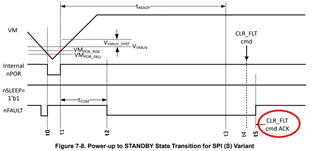Other Parts Discussed in Thread: DRV8908-Q1
Hi team!
The customer used DRV8243S Variant. And when the DRV8243S works normally, they adjust the VM to below 4V and the device can't work. They found that the VMUV is 0b, not 1b. I guess the DRV8243S Variant's reaction fixed to retry setting. Is that true? But when they adjust the VM to normal work level voltage, it doesn't work. Can you explain this case?







